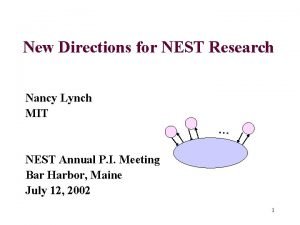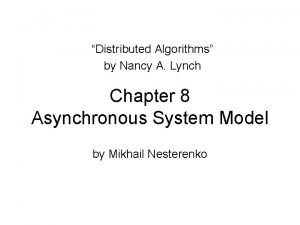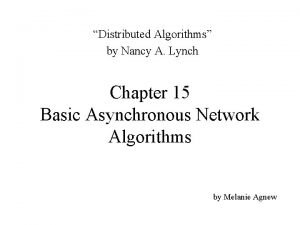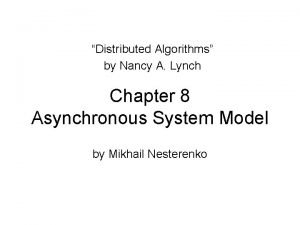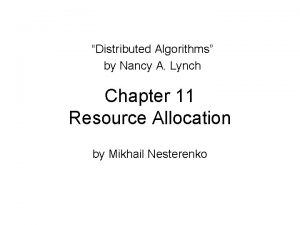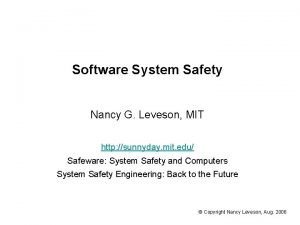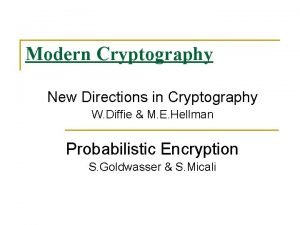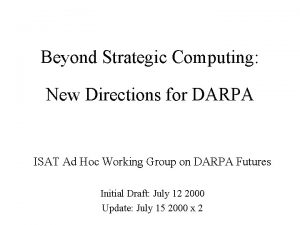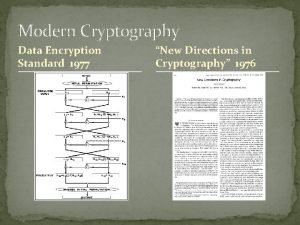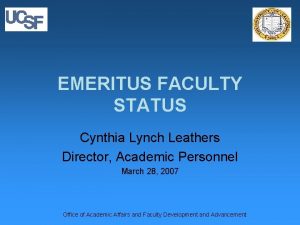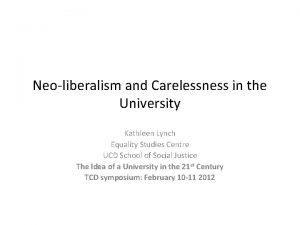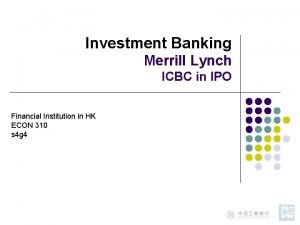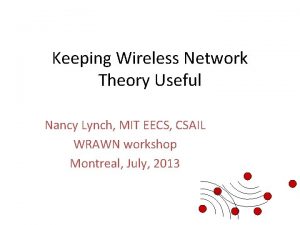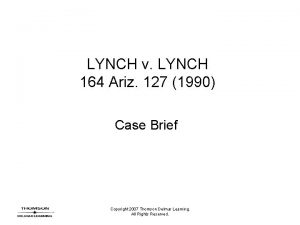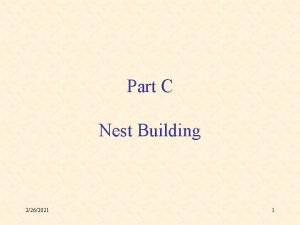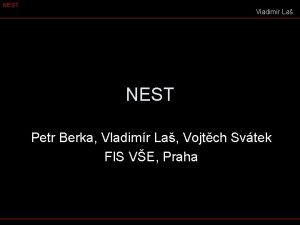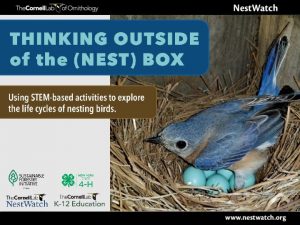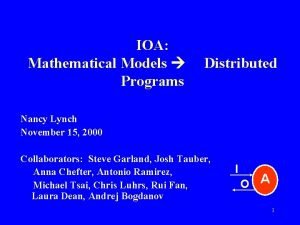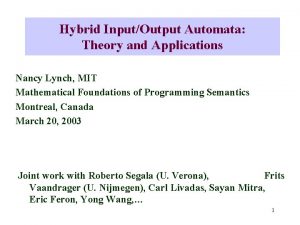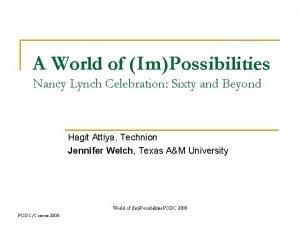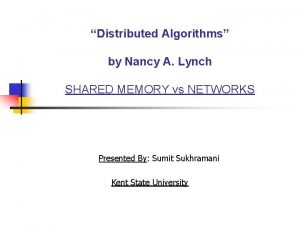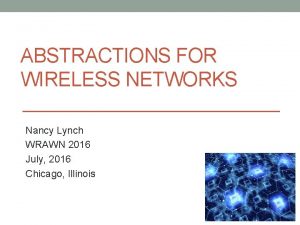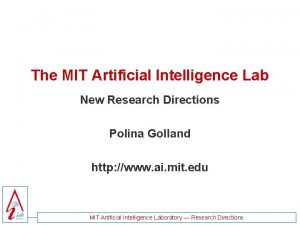New Directions for NEST Research Nancy Lynch MIT







![Current Subprojects • Scalable group communication [Khazan, Keidar, Lynch, Shvartsman] • Dynamic Atomic Broadcast Current Subprojects • Scalable group communication [Khazan, Keidar, Lynch, Shvartsman] • Dynamic Atomic Broadcast](https://slidetodoc.com/presentation_image/60484449f52905a94b163f204eac6382/image-8.jpg)


![1. Scalable Group Communication [Keidar, Khazan 00, 02] [Khazan 02] [K, K, Lynch, Shvartsman 1. Scalable Group Communication [Keidar, Khazan 00, 02] [Khazan 02] [K, K, Lynch, Shvartsman](https://slidetodoc.com/presentation_image/60484449f52905a94b163f204eac6382/image-11.jpg)


![New GC Service for WANs [Khazan] • New specification, including virtual synchrony. GCS • New GC Service for WANs [Khazan] • New specification, including virtual synchrony. GCS •](https://slidetodoc.com/presentation_image/60484449f52905a94b163f204eac6382/image-14.jpg)
![New GC Service for WANs • Distributed implementation [Tarashchanskiy] • Safety proofs, using new New GC Service for WANs • Distributed implementation [Tarashchanskiy] • Safety proofs, using new](https://slidetodoc.com/presentation_image/60484449f52905a94b163f204eac6382/image-15.jpg)
![2. Early-Delivery Dynamic Atomic Broadcast [Bar-Joseph, Keidar, Lynch, DISC 02] DAB 16 2. Early-Delivery Dynamic Atomic Broadcast [Bar-Joseph, Keidar, Lynch, DISC 02] DAB 16](https://slidetodoc.com/presentation_image/60484449f52905a94b163f204eac6382/image-16.jpg)










![3. Reconfigurable Atomic Memory for Basic Objects [Lynch, Shvartsman, DISC 02] RAMBO 27 3. Reconfigurable Atomic Memory for Basic Objects [Lynch, Shvartsman, DISC 02] RAMBO 27](https://slidetodoc.com/presentation_image/60484449f52905a94b163f204eac6382/image-27.jpg)

![Static Quorum-Based Atomic Read/Write Memory Implementation [Attiya, Bar-Noy, Dolev] • Read, Write use two Static Quorum-Based Atomic Read/Write Memory Implementation [Attiya, Bar-Noy, Dolev] • Read, Write use two](https://slidetodoc.com/presentation_image/60484449f52905a94b163f204eac6382/image-29.jpg)



![Consensus Implementation init(v) decide(v) init(v) Consensus • Use a variant of Paxos algorithm [Lamport] Consensus Implementation init(v) decide(v) init(v) Consensus • Use a variant of Paxos algorithm [Lamport]](https://slidetodoc.com/presentation_image/60484449f52905a94b163f204eac6382/image-33.jpg)




![Hybrid I/O Automata (HIOA) [Lynch, Segala, Vaandrager 01, 02] • Mathematical model for hybrid Hybrid I/O Automata (HIOA) [Lynch, Segala, Vaandrager 01, 02] • Mathematical model for hybrid](https://slidetodoc.com/presentation_image/60484449f52905a94b163f204eac6382/image-38.jpg)
![Timed I/O Automata, Probabilistic, … • Timed I/O Automata [Lynch, Segala, Vaandrager, Kirli]: – Timed I/O Automata, Probabilistic, … • Timed I/O Automata [Lynch, Segala, Vaandrager, Kirli]: –](https://slidetodoc.com/presentation_image/60484449f52905a94b163f204eac6382/image-39.jpg)

- Slides: 40

New Directions for NEST Research Nancy Lynch MIT … NEST Annual P. I. Meeting Bar Harbor, Maine July 12, 2002 1

My Group’s Work and NEST • New building blocks (global services and distributed algorithms) for dynamic, fault-prone, distributed systems. • Interacting state machine semantic models, including timing, hybrid continuous/discrete, probabilistic behavior. Composition, abstraction. • Formal methods/tools to support reasoning about distributed systems: Conditional performance analysis methods, IOA language/tools. • System modeling. 2

A Suggestion for NEST Research: a Middleware Service Catalog • Virtually everyone here is developing middleware services: – Clock synchronization, location services, routing, reliable communication, consensus, group membership, group communication, object management services, publish-subscribe, network surveillance, reconfiguration, authentication, key distribution, … • But it’s not always obvious exactly what these services guarantee: – API, functionality, conditional performance guarantees, faulttolerance guarantees 3

Middleware Service Catalog • Idea: Create and maintain a catalog of specifications for NEST middleware services. – High-level descriptions of requirements • Assumptions and guarantees • API, functionality, conditional performance, fault-tolerance • Formal, informal – Models of the distributed algorithms used in the various implementations. – Claims about the properties satisfied by the algorithms. – Models for the underlying platforms. • Why this would be useful: – – – Another kind of output, complementary to demos. Basis for discussion/clarification/comparison. Will help bring implementations together. Basis formal analysis. Can help in developing algorithmic theory for NEST-like systems. 4

Building Blocks for High -Performance, Fault-Tolerant Distributed Systems Nancy Lynch MIT … NEST Annual P. I. Meeting Bar Harbor, Maine July 12, 2002 5

Our Current Project (NSF- ITR and AFOSR) • Design and analyze building blocks for computing in highly dynamic distributed settings: – Global service specifications: … Servic e – Distributed algorithms that implement them: … … • Dynamic systems: Net – Internet, mobile computing – Joins, leaves, failures – Contrast: Traditional theory of distributed systems deals mostly with static systems, with fixed sets of processes. 6

Our Project • We present everything rigorously, using mathematical interacting state machine models (I/O automata). – Formal service specifications – Formal algorithm descriptions – Formal models for applications … … Net – Prove correctness, using invariants and simulation relations – Analyze performance, fault-tolerance • Develop supporting theory • Apply theory to software systems 7
![Current Subprojects Scalable group communication Khazan Keidar Lynch Shvartsman Dynamic Atomic Broadcast Current Subprojects • Scalable group communication [Khazan, Keidar, Lynch, Shvartsman] • Dynamic Atomic Broadcast](https://slidetodoc.com/presentation_image/60484449f52905a94b163f204eac6382/image-8.jpg)
Current Subprojects • Scalable group communication [Khazan, Keidar, Lynch, Shvartsman] • Dynamic Atomic Broadcast [Bar-Joseph, Keidar, Lynch] • Reconfigurable Atomic Memory [Lynch, Shvartsman] • Communication protocols [Livadas, Lynch, Keidar, Bakr] • Peer-to-peer computing [Lynch, Malkhi, Ratajczak, Stoica] • Fault-tolerant consensus [Keidar, Rajsbaum] • Foundations: [Lynch, Segala, Vaandrager, Kirli] • Applications: – – Toy helicopter [Mitra, Wang, Feron], Video streaming[Livadas, Nguyen, Zakhor], Unmanned flight control [Ha, Kochocki, Tanzman], Agent programming [Kawabe] 8

People • Project leader: Nancy Lynch • Postdocs: Idit Keidar, Dilsun Kirli • Ph. D students: Roger Khazan, Carl Livadas, Ziv Bar. Joseph, Rui Fan, Sayan Mitra, Seth Gilbert • MEng students: Omar Bakr, Matt Bachmann, Vida Ha • Other collaborators: Alex Shvartsman, Dahlia Malkhi, David Ratajczak, Ion Stoica, Sergio Rajsbaum, Roberto Segala, Frits Vaandrager, Yong Wang, Eric Feron, Thinh Nguyen, Avideh Zakhor, Joe Kochocki, Alan Tanzman, Yoshinobu Kawabe… 9

This talk: 1. Scalable Group Communication 2. Dynamic Atomic Broadcast 3. Reconfigurable Atomic Memory 10
![1 Scalable Group Communication Keidar Khazan 00 02 Khazan 02 K K Lynch Shvartsman 1. Scalable Group Communication [Keidar, Khazan 00, 02] [Khazan 02] [K, K, Lynch, Shvartsman](https://slidetodoc.com/presentation_image/60484449f52905a94b163f204eac6382/image-11.jpg)
1. Scalable Group Communication [Keidar, Khazan 00, 02] [Khazan 02] [K, K, Lynch, Shvartsman 02] … GCS 11

Group Communication Services • Cope with changing participants using abstract groups of client processes with changing membership sets. • Processes communicate with group members indirectly, by sending messages to the group as a whole. • GC services support management of groups: – Maintain membership information. • Form new views in response to changes. – Manage communication. • Communication respects views. • Provide guarantees about ordering, reliability of message delivery. • Virtual synchrony GCS • Systems; Isis, Transis, Totem, Ensemble, … 12

Group Communication Services • Advantages: – High-level programming abstraction – Hides complexity of coping with changes • Disadvantages: – Can be costly, especially when forming new views. – May have problems scaling to large networks. • Applications: – Managing replicated data – Distributed multiplayer interactive games – Multi-media conferencing, collaborative work 13
![New GC Service for WANs Khazan New specification including virtual synchrony GCS New GC Service for WANs [Khazan] • New specification, including virtual synchrony. GCS •](https://slidetodoc.com/presentation_image/60484449f52905a94b163f204eac6382/image-14.jpg)
New GC Service for WANs [Khazan] • New specification, including virtual synchrony. GCS • New algorithm: – Uses separate scalable membership service, implemented on a small set of membership servers [Keidar, Sussman, Marzullo, Dolev]. – Multicast implemented GCS on all the nodes. Memb Net – View change uses only one round for state exchange, in parallel with membership service’s agreement on views. – Participants can join during view formation. 14
![New GC Service for WANs Distributed implementation Tarashchanskiy Safety proofs using new New GC Service for WANs • Distributed implementation [Tarashchanskiy] • Safety proofs, using new](https://slidetodoc.com/presentation_image/60484449f52905a94b163f204eac6382/image-15.jpg)
New GC Service for WANs • Distributed implementation [Tarashchanskiy] • Safety proofs, using new incremental proof methods [Keidar, Khazan, Lynch, Shvartsman 00]. S S’ • Liveness proofs A A’ • Performance analysis – Analyze time from when network stabilizes until GCS announces new views. – Analyze message latency. – Conditional analysis, based on input, failure, and timing assumptions. – Compositional analysis, based on performance of Membership Service and Net. • Also modeled analyzed data-management application running on top of the new GCS. 15
![2 EarlyDelivery Dynamic Atomic Broadcast BarJoseph Keidar Lynch DISC 02 DAB 16 2. Early-Delivery Dynamic Atomic Broadcast [Bar-Joseph, Keidar, Lynch, DISC 02] DAB 16](https://slidetodoc.com/presentation_image/60484449f52905a94b163f204eac6382/image-16.jpg)
2. Early-Delivery Dynamic Atomic Broadcast [Bar-Joseph, Keidar, Lynch, DISC 02] DAB 16

Dynamic Atomic Broadcast • Atomic broadcast with latency guarantees, in a dynamic setting where processes may join, leave, or fail. • We define the DAB problem, and present and analyze a new distributed algorithm to solve it. • In the absence of failures: Constant latency, even when participants join and leave. • With failures: Latency linear in the number of failures. • Uses a new distributed consensus service, in which participants do not know who the other participants are. • We define the CUP problem, and present and analyze a new algorithm to solve it. • Algorithm improves upon previously-suggested algorithms using group communication. 17

The DAB Problem join leave mcast(m) join-ack leave-ack rcv(m) … join-ack DAB • Problem: Guarantee participants receive consistent sequences of messages. Fast delivery, even with joins, leaves. • Safety: Sending, receiving orders are consistent with a single global message ordering S. No gaps. • Liveness: Eventual join-ack, leave-ack. Eventual delivery, including the first message the process itself sends. • Application: Distributed multiplayer interactive games. 18

Implementing DAB join DAB net-join Net • Processes: – Timing-dependent, have approximately-synchronized clocks. • Net: – Dynamic network, pairwise FIFO delivery – Low latency – Does not guarantee a single total order, nor that all processes see the same messages from a failing process. 19

Implementing DAB • Key difficulties: – Network doesn’t guarantee a single total order. – Different processes may receive different final messages from a failed process. • So, processes coordinate message delivery: – Divide time into slots using local clock, assign each message to a slot. – Deliver messages in order of (slot, sender id). – Determine members of each slot, deliver only from members. • Processes must agree on slot membership – Joining (leaving) process selects join-slot (leave-slot), informs other processes. – Failed process triggers consensus. 20

Using Consensus for DAB • When process j fails, a consensus service is used to agree on j’s failure slot. • Requires a new kind of consensus service, which: – Does not assume participants are known a priori; lets each participant say who it thinks the other participants are. – Allows processes to abstain. – Example: i joins around when consensus starts. j 1 thinks i is participating, j 2 thinks not. i cannot participate as usual, because j 2 ignores it, but cannot be silent, because j 1 waits for it. So i abstains. • We define new Consensus with Unknown Participants (CUP) service. • Use separate CUP(j) service to decide on failure slot for j. 21

The DAB Algorithm Using CUP DAB fail DABi 1 DABi 2 fail CUP(j) Net 22

The CUP Problem init(v, W) abstain leave-detect(j) fail-detect(j) init(v, W) decide(v) CUP • Guarantees agreement, validity, termination. • Assumes submitted worlds are “close”: – Process that initiates is in other processes’ worlds – Process in anyone’s world initiates, abstains, leaves, or fails. 23

The CUP Algorithm CUP Net • We give a new early-stopping consensus algorithm. – Similar to previous algorithms, e. g. , [Dolev, Reischuk, Strong 90]. – But tolerates: • Uncertainty about participants, • Processes leaving. • Terminates in two rounds when failures stop (even if leaves continue). 24 • Latency linear in number of actual failures

The DAB Algorithm Using CUP DABi 1 DABi 2 CUP(j 1) Net 25

Discussion: DAB • Modular: DAB algorithm, CUP, Network • Modularity needed for keeping the complexity under control. • Initial presentation was intertwined, not modular. • Correctness of CUP (agreement, validity, termination) used to prove correctness of DAB (atomic broadcast safety and liveness guarantees). • Latency bounds for CUP used to prove latency bounds for DAB. 26
![3 Reconfigurable Atomic Memory for Basic Objects Lynch Shvartsman DISC 02 RAMBO 27 3. Reconfigurable Atomic Memory for Basic Objects [Lynch, Shvartsman, DISC 02] RAMBO 27](https://slidetodoc.com/presentation_image/60484449f52905a94b163f204eac6382/image-27.jpg)
3. Reconfigurable Atomic Memory for Basic Objects [Lynch, Shvartsman, DISC 02] RAMBO 27

RAMBO • Defined new service: Reconfigurable Atomic Memory for Basic Objects (dynamic atomic read/write shared memory). • Developed new, efficient, modular distributed algorithm to implement RAMBO. • Highly survivable; tolerates joins, leaves, failures. • Tolerates short-term changes by using quorums. • Tolerates long-term changes by reconfiguring. – Reconfigures on-the-fly; no heavyweight view change. – Maintains atomicity across configuration changes. • Can be used in mobile or peer-to-peer settings. • Applications: Battle data for teams of soldiers, game data for players in multiplayer game. 28
![Static QuorumBased Atomic ReadWrite Memory Implementation Attiya BarNoy Dolev Read Write use two Static Quorum-Based Atomic Read/Write Memory Implementation [Attiya, Bar-Noy, Dolev] • Read, Write use two](https://slidetodoc.com/presentation_image/60484449f52905a94b163f204eac6382/image-29.jpg)
Static Quorum-Based Atomic Read/Write Memory Implementation [Attiya, Bar-Noy, Dolev] • Read, Write use two phases: – Phase 1: Read (value, tag) from a read-quorum – Phase 2: Write (value, tag) to a write-quorum • Write determines largest tag in phase 1, picks a larger one, writes new (value, tag) in phase 2. • Read determines latest (value, tag) in phase 1, propagates it in phase 2, then returns the value. – Could return unconfirmed value after phase 1. • Highly concurrent. • Quorum intersection property implies atomicity. 29

How to make this dynamic? • Quorum members may join, leave, fail; need to reconfigure. • Idea: Any member of current quorum configuration can propose a new configuration. • Questions: – – How to agree on new configuration? How to install it? How to preserve atomicity of data during reconfiguration? How to avoid stopping Reads/Writes in progress? 30

Our RAMBO Algorithm • Uses a separate reconfiguration service. read, write new-config Recon Net recon 31

Recon Using Consensus • Recon service uses (static) consensus services to determine new configurations 1, 2, 3, … recon-ack recon Recon Consensus Net • Consensus is a fairly heavyweight mechanism, but: – Only used for reconfigurations, which are presumably infrequent. – Does not delay Read/Write operations (unlike GCS approaches). 32
![Consensus Implementation initv decidev initv Consensus Use a variant of Paxos algorithm Lamport Consensus Implementation init(v) decide(v) init(v) Consensus • Use a variant of Paxos algorithm [Lamport]](https://slidetodoc.com/presentation_image/60484449f52905a94b163f204eac6382/image-33.jpg)
Consensus Implementation init(v) decide(v) init(v) Consensus • Use a variant of Paxos algorithm [Lamport] • Agreement, validity guaranteed absolutely. • Termination guaranteed when underlying system stabilizes. • Leader chosen using failure detectors; conducts twophase algorithm with retries. 33

Read/Write Algorithm using Recon read, write new-config Recon Net • Read/write processes run two-phase static quorum-based algorithm, using current configuration. • Use gossiping and fixed point tests rather than highly structured communication. • When Recon provides new configuration, R/W uses both. • Do not abort R/W in progress, but do extra work to access 34 additional processes needed for new quorums.

Removing Old Configurations • Read/Write algorithm removes old configurations by garbage-collecting them in the background. • Two-phase garbage-collection procedure: – Phase 1: Inform write-quorum of old configuration about the new configuration. Collect latest value from read-quorum of old configuration. – Phase 2: Inform write-quorum of new configuration about latest value. • Garbage-collection concurrent with Reads/Writes. • Implemented using gossiping and fixed points. 35

Discussion: RAMBO • Highly modular: R/W algorithm, Recon service, Consensus, Leader election, Network • Modularity needed for keeping the complexity under control. • Correctness proofs: – Atomicity of Reads and Writes • Latency bounds: – For reading, writing, garbage-collection. – Under various assumptions about timing, joins, failures, and rate of reconfiguration. • LAN implementations begun. 36

Foundations: Hybrid, Timed, Probabilistic Models 37
![Hybrid IO Automata HIOA Lynch Segala Vaandrager 01 02 Mathematical model for hybrid Hybrid I/O Automata (HIOA) [Lynch, Segala, Vaandrager 01, 02] • Mathematical model for hybrid](https://slidetodoc.com/presentation_image/60484449f52905a94b163f204eac6382/image-38.jpg)
Hybrid I/O Automata (HIOA) [Lynch, Segala, Vaandrager 01, 02] • Mathematical model for hybrid (continuous/discrete) system components. • Discrete actions, continuous trajectories P • Supports composition, levels of abstraction. A • Case studies: S C – Automated transportation systems – Quanser helicopter system [Mitra, Wang, Feron, Lynch] 38
![Timed IO Automata Probabilistic Timed IO Automata Lynch Segala Vaandrager Kirli Timed I/O Automata, Probabilistic, … • Timed I/O Automata [Lynch, Segala, Vaandrager, Kirli]: –](https://slidetodoc.com/presentation_image/60484449f52905a94b163f204eac6382/image-39.jpg)
Timed I/O Automata, Probabilistic, … • Timed I/O Automata [Lynch, Segala, Vaandrager, Kirli]: – For modeling and analyzing timing-based systems, most of the building blocks of our AFOSR project. – Support composition, abstraction. – Collecting ideas from many research papers. e. g. , • Probabilistic I/O automata [Lynch, Segala, Vaandrager]: – For modeling systems with random behavior. – Composition, abstraction aspects still need development. – Need to be combined with timed/hybrid models. 39

Conclusions • Three main building blocks (services and algorithms) for dynamic systems: – Scalable Group Communication – Dynamic Atomic Broadcast – Reconfigurable Atomic Memory • Auxiliary building blocks: group membership, Consensus with Unknown Participants, reconfiguration • Much remains to be done, to produce a “complete” set of useful building blocks for dynamic systems, and a good algorithmic theory for this area. • Connections with NEST? 40
 Nancy lynch mit
Nancy lynch mit Distributed algorithms nancy lynch
Distributed algorithms nancy lynch Distributed algorithms nancy lynch
Distributed algorithms nancy lynch Distributed algorithms nancy lynch
Distributed algorithms nancy lynch Distributed algorithms lynch
Distributed algorithms lynch New directions for institutional research
New directions for institutional research Nancy leveson
Nancy leveson New directions in cryptography
New directions in cryptography 1976 new directions in cryptology
1976 new directions in cryptology New directions hse
New directions hse Chapter 2 new directions in learning
Chapter 2 new directions in learning Darpa isat
Darpa isat New directions blackburn
New directions blackburn New directions in cryptography
New directions in cryptography Rijandael
Rijandael Brass v drape
Brass v drape Tilley's antral burr
Tilley's antral burr Erin dougherty lynch
Erin dougherty lynch Aifs
Aifs Pph treatment algorithm
Pph treatment algorithm Merrill lynch strategic balanced index
Merrill lynch strategic balanced index Jason lynch football
Jason lynch football Mallory lynch
Mallory lynch Dr cynthia lynch
Dr cynthia lynch Christopher lynch tenor
Christopher lynch tenor Debbie lynch white age
Debbie lynch white age Willie lynch letters
Willie lynch letters William henry lynch
William henry lynch Oxitocina sublingual
Oxitocina sublingual Astler coller sınıflaması
Astler coller sınıflaması Lynch sendromu amsterdam kriterleri
Lynch sendromu amsterdam kriterleri Patrick lynch head injury colorado
Patrick lynch head injury colorado Alison lynch md
Alison lynch md Dr harry lynch
Dr harry lynch Status anxiety
Status anxiety Gregory crewdson ophelia analysis
Gregory crewdson ophelia analysis Lynch syndrome medbullets
Lynch syndrome medbullets Lynch
Lynch Marshawn lynch training mask
Marshawn lynch training mask Kathleen lynch ucd
Kathleen lynch ucd Lynch group ipo
Lynch group ipo
